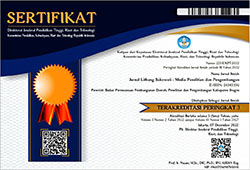ANALISIS PRIORITAS PEMBANGUNAN WILAYAH BERDASARKAN SEKTOR PRODUK DOMESTIK REGIONAL BRUTO KABUPATEN TAPANULI TENGAH-SUMATERA UTARA
DOI:
https://doi.org/10.32630/sukowati.v2i1.38Kata Kunci:
Keywords: economic potential, typologi klassen, loqation question, shift shareAbstrak
Abstraksi. Penelitian ini bertujuan untuk menganalisis klasifikasi pertumbuhan sektor perekonomian, menganalisis pergeseran sektor perekonomian dan mengidentifikasi sektor unggulan di Kabupaten Tapanuli Tengah Provinsi Sumatera Utara untuk penentuan prioritas pembangunan daerah. Penelitian ini menggunakan 3 (tiga) analisis yaitu: typologi klassen (TK), loqation question (LQ) dan shift share(SS). Analisis TK menunjukkan bahwa kabupaten tapanuli tengah termasuk daerah yang mempunyai potensi untuk berkembang dan tumbuh secara ekonomi di Sumatera Utara. Analisis LQ menunjukkan bahwa pada sektor pertanian, kehutanan dan perikanan, sektor pengadaan listrik dan gas, sektor pengadaan air, pengelolaan sampah, limbah dan daur ulang dan sektor administrasi pemerintahan, pertahanan dan jaminan sosial wajib merupakan sektor unggulan di Kabupaten Tapanuli Tengah. Sedangkan analisis SS menunjukkan bahwa pada sektor pertambangan dan penggalian, pengadaan listrik dan gas, pengadaan air, pengelolaan sampah, limbah dan daur ulang, konstruksi, perdagangan besar dan eceran reparasi mobil dan sepeda motor, transportasi dan pergudangan, penyediaan akomodasi dan makan minum, jasa keuangan dan asuransi, administrasi pemerintahan, pertahanan dan jaminan sosial wajib mempunyai daya saing yang tinggi dan berpotensi untuk maju dan tumbuh yang dapat meningkatkan pertumbuhan ekonomi Kabupaten Tapanuli Tengah.


















